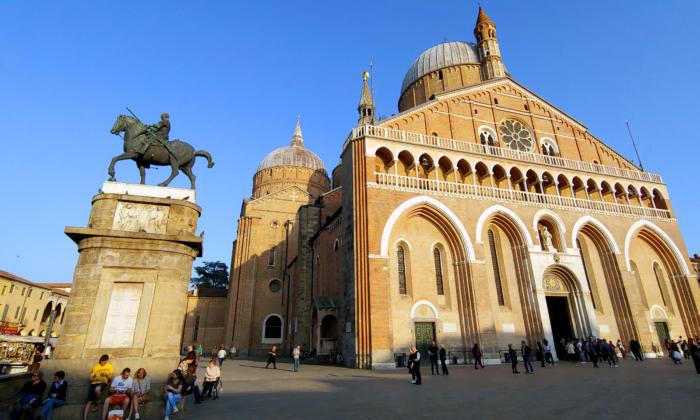At Padua’s Piazza delle Erbe, the market is closed, the merchants are gone, and shadows have replaced harsh sunlight. As if waiting to reclaim their square, students spill out of colorful bars—drinks in hand. Clustered around tall but tiny round tables—tipsy on the big, rough cobbles—they sip their drinks and dip bread in shallow dishes of plush olive oil. Their drink of choice is a spritz, an apéritif made with a bitter alcoholic liqueur (Campari or Aperol), prosecco (or white wine), and soda, garnished with a bright orange wedge.
Like them, I order my spritz “to go” (da portar via), and join the gang out on the piazza. Taking my cue from others at the table, I rip my bread into a long strand, dip, and munch. The guy next to me, Alessandro, seems right out of the Renaissance—with a billowing white blouse and an abundant head of long, curly hair. He says, “You make the scarpetta … we call it the ‘little shoe.’” As I yellow the tip of my bread in the oil, I see what he means. I bite off the foot and dip another.
Reviewing my day, I marvel at what a treat Padua is—just 30 minutes by train from jam-packed Venice, and yet, far less touristy.
Each morning, Piazza delle Erbe (so popular after hours with congregating students) is an almost exotic-feeling market—long famous for its vast selection of fresh herbs, fruits, and vegetables.
The students here know that their University of Padua is one of the oldest, greatest, and historically progressive schools in Europe. Back in 1222, when the Church controlled university curricula, a group of professors and students broke free from the University of Bologna and created this liberal school, independent of Catholic constraints and accessible to people of alternative faiths.
A haven for free thought, Padua attracted intellectuals from all over Europe, including the great astronomers Copernicus and Galileo—notorious for disagreeing with the Church’s views on science. Galileo called his 18 years on the faculty here the best of his life. I imagine today’s students, who gather in ancient courtyards surrounded by memories of illustrious alumni, treasure their years here, too.
Tourists visiting the university are treated to a peek at the world’s first permanent anatomy theater, which dates from the 1500s. Despite the Church’s strict ban on autopsies, students would pack into this theater to watch professors dissect human cadavers. If the Church came a-knockin’, the table could be flipped, allowing the corpse to fall into a river below and be replaced with an animal.
Padua’s colonnaded old town boasts cultural treasures that hold their own in Italy’s artistic big league, such as the Scrovegni Chapel and the Basilica of St. Anthony.
The glorious Scrovegni Chapel is wallpapered with Giotto’s beautifully preserved cycle of nearly 40 frescoes depicting scenes from the lives of Jesus and Mary. Finished in 1305, it’s considered by many to be the first piece of Renaissance art—a sign that Europe was breaking out of the Middle Ages. Giotto placed real people in real scenes, expressing real human emotions.
To protect the paintings from excess humidity, only 25 people are allowed inside the chapel at a time. Reservations are required (www.cappelladegliscrovegni.it). At your appointed time, you enter an anteroom to watch a video before enjoying 15 minutes in Giotto’s unforgettable chapel.
The popular St. Anthony—patron saint of travelers, amputees, donkeys, pregnant women, barren women, flight attendants, and pig farmers—is buried here in Padua. For nearly 800 years, the Basilica of St. Anthony, with his tomb and miraculously preserved tongue, has attracted pilgrims. Most of them ask for his help as the “finder of things,” from misplaced car keys to a life companion. A steady progression of pilgrims, who believe Anthony is their protector—a confidant and intercessor of the poor—shuffle past his ornate tomb, then his “uncorrupted tongue,” praying for help or giving thanks for miracles they believe he’s performed.
Whether you’re a faith-driven pilgrim or a free-spirited astronomer, Padua feeds your soul. As darkness settles on Padua’s market square and the students head home for dinner, I finish off my spritz and dip a few last strips of bread into the olive oil. Saying goodbye to Alessandro, it occurs to me how travel, too, is like making the scarpetta: By dipping into the rich and tasty cultural treats of distant lands, and savoring them with the people who call those lands home, any traveler can “make the little shoe.”
Dear Readers: We would love to hear from you. What topics would you like to read about? Please send your feedback and tips to [email protected].




